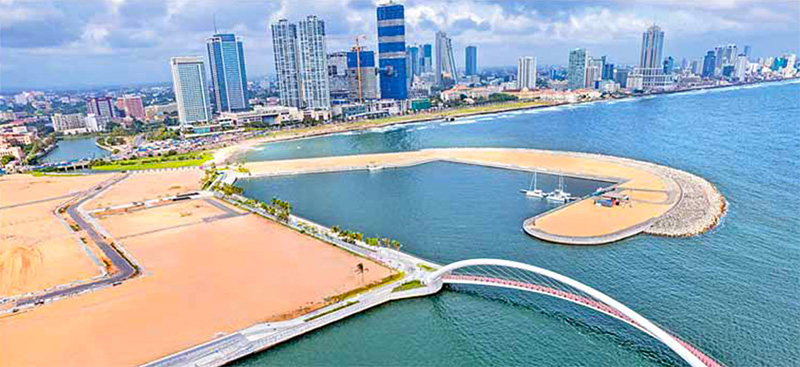Business
Port City Colombo seen as dynamic driver of SL’s development

With the aim of becoming a world-class hub for corporate relations and the engine of Sri Lanka’s future economic development, Port City Colombo will empower large-scale business growth within the South Asian region through a reliable and competitive regulatory environment that enhances the ease of doing business, a Port City Colombo press release said.
The release adds: ‘This progressive economically ring-fenced landscape is projected to reinvent the Sri Lankan economy, from one that has been traditionally focused on manufacturing and tourism to a contemporary system that is geared towards the export of services. With strategic drivers, including the ability to transact in sixteen different foreign currencies, 100% capital and profit repatriation, and 100% foreign ownership, Port City Colombo provides favourable conditions for international businesses to invest and set up operations, whilst fostering an increase in job creation and attraction of top talent for not just Sri Lanka, but also South Asia as a whole.
‘By driving trends in information technology, logistics, commercial services and more, Port City Colombo also aims to stimulate growth in Foreign Exchange through key business investments, which would further contribute to Sri Lanka’s economic development.
‘Showcasing a strong emphasis on inviting a higher influx of foreign direct investments, Port City Colombo enables commercial entities to become qualified as Businesses of Strategic Importance (BSI’s), which are designated Authorised Persons (AP’s) with a higher eligibility for incentives. This streamlined process is governed by the Colombo Port City Economic Commission, the single-window facilitator that regulates and administers all matters connected with businesses and other operations within the vicinity and from the area of authority of the Colombo Port City Special Economic Zone.
‘To be considered a Primary Business of Strategic Importance, companies are necessitated to demonstrate interest in real estate, social infrastructure, or commercial property development, and meet the threshold of a minimum investment of USD 100 million per land plot or USD 25 million per social infrastructure plot.
‘Corporate entities, who are interested in setting up business operations, could qualify as Secondary Businesses of Strategic Importance under the one of the following criteria: an annual global revenue of more than USD 50 million; a minimum of 100 employees within five years from commencement of operations; or an entrepreneurial venture with a valuation of at least USD 500,000. Apart from the above criteria, businesses also have the option of showcasing a contribution towards the social and commercial advancement of Sri Lanka by fostering innovation, knowledge transfer, technology transfer, research and development.
‘Reinforcing the long-term vision of transforming Sri Lanka into a prime destination for business and innovation, Port City Colombo demonstrates its readiness for global and regional investment through the project’s intriguing multi-sector opportunities. For information about Port City Colombo’s investment opportunities, please visit www.portcitycolombo.lk.
Business
Sri Lanka betting its tourism future on cold, hard numbers

National Airport Exit Survey tells quite a story
Australia’s role here is strategic, not charitable
In a quiet but significant shift, Sri Lanka’s tourism sector is moving beyond traditional destination marketing and instinct-based planning. The recent launch of the “From Data to Decisions” initiative jointly backed by Australia’s Market Development Facility and the Sri Lanka Tourism Development Authority, sent an unambiguous message: sentiment is out, statistics are in.
The initiative is anchored by a 12-month National Airport Exit Survey, a trove of data covering 16,000 travellers. The findings sketch a new traveller profile: nearly half are young (20–35), independent, and book online. Galle, Ella, and Sigiriya are the hotspots; women travellers outnumber men; and a promising 45% plan to return. This isn’t just trivia. It’s a strategic blueprint. If Sri Lanka Tourism listens, it can tailor everything from infrastructure to marketing, moving from guesswork to precision.
The keynote speaker, Deputy Minister Prof. Ruwan Ranasinghe called data “a vital pillar of tourism transformation.” Yet the unspoken truth is that Sri Lanka has long relied on generic appeals -beaches, heritage, smiles. In today’s crowded market, that’s no longer enough. As SLTDA Chairman Buddhika Hewawasam noted, this partnership is about “elevating how we collect, analyse, and use data.”
Australia’s role here is strategic, not charitable. By funding research and advocating for a Tourism Satellite Account, it is helping Sri Lanka build a tourism sector that is both sustainable and measurable. Australian High Commissioner Matthew Duckworth linked this support to “global standards of environmental protection” – a clear nod to the growing demand for green travel. This isn’t just aid; it’s influence through insight.
“The real test lies ahead,” a tourism expert told The Island. “Data is only as good as the decisions it drives. Will these insights overcome bureaucratic inertia? Will marketing budgets actually follow the evidence toward younger, independent, female travellers?,” he asked.
“The comprehensive report promised for early 2026 must move swiftly from recommendation to action. In an era where destinations are discovered on Instagram and planned with algorithms, intuition alone is a high-stakes gamble. This forum made one thing clear: Sri Lanka is finally building its future on what visitors actually do – not just what we hope they’ll do. The numbers are in. Now, the industry must dare to follow them,” he said.
By Sanath Nanayakkare
Business
New ATA Chair champions Asia’s small tea farmers, unveils ambitious agenda

In his inaugural address as the new Chairman of the Asia Tea Alliance (ATA), Nimal Udugampola placed the region’s millions of smallholders at the core of the global tea industry’s future, asserting they are the “indispensable engine” of a sector that produces over 90% of the world’s tea.
Udugampola, who is also Chairman of Sri Lanka’s Tea Smallholdings Development Authority, used his speech at the 6th ATA Summit held in Colombo on Nov. 27 to declare that the prosperity of Asian tea is “entirely contingent” on the resilience of its small-scale farmers, who have historically been overlooked by premium global markets.
“In Sri Lanka, smallholders account for over 75% of our national production. Across Asia, millions of families maintain the quality and character of our regional teas,” he stated, accepting the chairmanship for the 2025-2027 term.
To empower this vital community, Udugampola unveiled a vision focused on Sustainability, Equity, and Digital Transformation. The strategic agenda includes:
Climate Resilience: Promoting climate-smart agriculture and regenerative farming to protect smallholdings from environmental disruption.
Digital Equity: Leveraging technology like blockchain to create farm-to-cup traceability, connecting smallholders directly with premium consumers and ensuring fair value.
Market Expansion: Driving innovation in tea products and marketing to attract younger consumers and enter non-traditional markets.
Standard Harmonization: Establishing common regional quality and sustainability standards to protect the “Asian Tea” brand and push for stable, fair pricing.
Linking the alliance’s goals to national ambition, Udugampola highlighted Sri Lanka’s target of producing 400 million kilograms of tea by 2030. He presented the country’s “Pivithuru Tea Initiative” as a model for other ATA nations, designed to achieve this through smallholder empowerment, digitalization, and aligned policy objectives.
By Sanath Nanayakkare
Business
Brandix recognised as Green Brand of Year at SLIM Awards 2025

Brandix Apparel Solutions was recognised as the Green Brand of the Year at the Sri Lanka Institute of Marketing (SLIM) Brand Excellence Awards 2025, taking home Silver, the highest award presented in the category this year.
The ‘Green Brand of the Year’ recognises the brand that drives measurable environmental impact through sustainable practices, climate-aligned goals and long-term commitment to protecting natural resources.
A pioneer in responsible apparel manufacturing for over two decades, Brandix has championed best practices in the sphere of sustainable manufacturing covering environmental, social, and governance aspects. The company built the world’s first Net Zero Carbon-certified apparel manufacturing facility (across Scope 1 and Scope 2) and meets over 60% of its energy requirement in Sri Lanka via renewable sources.
Head of ESG at Brandix, Nirmal Perera, said: “Being recognised as Green Brand of the Year is an encouraging milestone for our teams working across sustainability.”
-
News6 days ago
Lunuwila tragedy not caused by those videoing Bell 212: SLAF
-

 News22 hours ago
News22 hours agoOver 35,000 drug offenders nabbed in 36 days
-

 News5 days ago
News5 days agoLevel III landslide early warning continue to be in force in the districts of Kandy, Kegalle, Kurunegala and Matale
-

 Features7 days ago
Features7 days agoDitwah: An unusual cyclone
-

 Business3 days ago
Business3 days agoLOLC Finance Factoring powers business growth
-

 News3 days ago
News3 days agoCPC delegation meets JVP for talks on disaster response
-

 News3 days ago
News3 days agoA 6th Year Accolade: The Eternal Opulence of My Fair Lady
-

 News22 hours ago
News22 hours agoRising water level in Malwathu Oya triggers alert in Thanthirimale


























